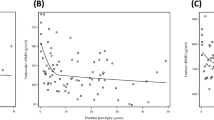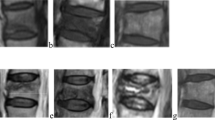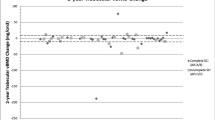Abstract
Summary
Marked trabecular and cortical bone loss was observed at the proximal femur short-term after spinal cord injury (SCI). 3D-DXA provided measurement of vBMD evolution at both femoral compartments and cortical thinning, thereby suggesting that this technique could be useful for bone analysis in these patients.
Introduction
SCI is associated with a marked increase in bone loss and risk of osteoporosis development short-term after injury. 3D-DXA is a new imaging analysis technique providing 3D analysis of the cortical and trabecular bone from DXA scans. The aim of this study was to assess the evolution of trabecular macrostructure and cortical bone using 3D-DXA in patients with recent SCI followed over 12 months.
Methods
Sixteen males with recent SCI (< 3 months since injury) and without antiosteoporotic treatment were included. Clinical assessment, bone mineral density (BMD) measurements by DXA, and 3D-DXA evaluation at proximal femur (analyzing the integral, trabecular and cortical volumetric BMD [vBMD] and cortical thickness) were performed at baseline and at 6 and 12 months of follow-up.
Results
vBMD significantly decreased at integral, trabecular, and cortical compartments at 6 months (− 8.8, − 11.6, and − 2.4%), with a further decrease at 12 months, resulting in an overall decrease of − 16.6, − 21.9, and − 5.0%, respectively. Cortical thickness also decreased at 6 and 12 months (− 8.0 and − 11.4%), with the maximal decrease being observed during the first 6 months. The mean BMD losses by DXA at femoral neck and total femur were − 17.7 and − 21.1%, at 12 months, respectively.
Conclusions
Marked trabecular and cortical bone loss was observed at the proximal femur short-term after SCI. 3D-DXA measured vBMD evolution at both femoral compartments and cortical thinning, providing better knowledge of their differential contributory role to bone strength and probably of the effect of therapy in these patients.


Similar content being viewed by others
Abbreviations
- SCI:
-
Spinal cord injury
- BMD:
-
Bone mineral density
- DXA:
-
Dual-energy X-ray absorptiometry
- QCT:
-
Quantitative computed tomography
- BMC:
-
Bone mineral content
- vBMD:
-
Volumetric bone mineral density
- 3D-DXA:
-
Three-dimensional dual-energy X-ray absorptiometry
- BMI:
-
Body mass index
- AIS:
-
ASIA Impairment Scale
- aBMD:
-
Areal bone mineral density
- SD:
-
Standard deviation
References
Jiang SD, Dai LY, Jiang LS (2006) Osteoporosis after spinal cord injury. Osteoporos Int 17(2):180–192
Giangregorio L, McCartney N (2006) Bone loss and muscle atrophy in spinal cord injury: epidemiology, fracture prediction, and rehabilitation strategies. J Spinal Cord Med 29(5):489–500
Gifre L, Vidal J, Carrasco JL, Filella X, Ruiz-Gaspà S, Muxi A, Portell E, Monegal A, Guañabens N, Peris P (2015) Effect of recent spinal cord injury on wnt signaling antagonists (sclerostin and dkk-1) and their relationship with bone loss. A 12-month prospective study. J Bone Miner Res 30(6):1014–1021
Biering-Sørensen F, Bohr HH, Schaadt OP (1990) Longitudinal study of bone mineral content in the lumbar spine, the forearm and the lower extremities after spinal cord injury. Eur J Clin Investig 20(3):330–335
Garland DE, Stewart CA, Adkins RH, SS H, Rosen C, Liotta FJ, Weinstein DA (1992) Osteoporosis after spinal cord injury. J Orthop Res 10(3):371–378
Edwards WB, Schnitzer TJ (2015) Bone imaging and fracture risk after spinal cord injury. Curr Osteoporos Rep 13(5):310–317
Edwards WB, Schnitzer TJ, Troy KL (2014) Reduction in proximal femoral strength in patients with acute spinal cord injury. J Bone Miner Res 29(9):2074–2079
Bauman WA, Cirnigliaro CM, La Fountaine MF, Martinez L, Kirshblum SC, Spungen AM (2015) Zoledronic acid administration failed to prevent bone loss at the knee in persons with acute spinal cord injury: an observational cohort study. J Bone Miner Metab 33(4):410–421
Bubbear JS, Gall A, Middleton FR, Ferguson-Pell M, Swaminathan R, Keen RW (2011) Early treatment with zoledronic acid prevents bone loss at the hip following acute spinal cord injury. Osteoporos Int 22(1):271–279
Shapiro J, Smith B, Beck T, Ballard P, Dapthary M, BrintzenhofeSzoc K, Caminis J (2007) Treatment with zoledronic acid ameliorates negative geometric changes in the proximal femur following acute spinal cord injury. Calcif Tissue Int 80(5):316–322
Gilchrist NL, Frampton CM, Acland RH, Nicholls MG, March RL, Maguire P, Heard A, Reilly P, Marshall K (2007) Alendronate prevents bone loss in patients with acute spinal cord injury: a randomized, double-blind, placebo-controlled study. J Clin Endocrinol Metab 92(4):1385–1390
Garland DE, Adkins RH, Stewart CA (2008) Five-year longitudinal bone evaluations in individuals with chronic complete spinal cord injury. J Spinal Cord Med. 31(5):543–550
Zehnder Y, Risi S, Michel D, Knecht H, Perrelet R, Kraenzlin M, Zäch GA, Lippuner K (2004) Prevention of bone loss in paraplegics over 2 years with alendronate. J Bone Miner Res 19(7):1067–1074
Zehnder Y, Lüthi M, Michel D, Knecht H, Perrelet R, Neto I, Kraenzlin M, Zäch G, Lippuner K (2004) Long-term changes in bone metabolism, bone mineral density, quantitative ultrasound parameters, and fracture incidence after spinal cord injury: a cross-sectional observational study in 100 paraplegic men. Osteoporos Int 15(3):180–189
Gifre L, Vidal J, Carrasco JL, Muxi A, Portell E, Monegal A, Guañabens N, Peris P (2015) Risk factors for the development of osteoporosis after spinal cord injury. A 12-month follow-up study. Osteoporos Int 26(9):2273–2280
Dudley-Javoroski S, Shields RK (2012) Regional cortical and trabecular bone loss after spinal cord injury. J Rehabil Res Dev 49(9):1365–1376
Coupaud S, McLean AN, Purcell M, Fraser MH, Allan DB (2015) Decreases in bone mineral density at cortical and trabecular sites in the tibia and femur during the first year of spinal cord injury. Bone 74:69–75
Edwards WB, Schnitzer TJ, Troy KL (2013) Bone mineral loss at the proximal femur in acute spinal cord injury. Osteoporos Int 24(9):2461–2469
Edwards WB, Schnitzer TJ, Troy KL (2014) Bone mineral and stiffness loss at the distal femur and proximal tibia in acute spinal cord injury. Osteoporos Int 25(3):1005–1015
Eser P, Frotzler A, Zehnder Y, Denoth J (2005) Fracture threshold in the femur and tibia of people with spinal cord injury as determined by peripheral quantitative computed tomography. Arch Phys Med Rehabil 86(3):498–504
Kolta S, Le Bras A, Mitton D, Bousson V, de Guise JA, Fechtenbaum J, Laredo JD, Roux C, Skalli W (2005) Three-dimensional X-ray absorptiometry (3D-XA): a method for reconstruction of human bones using a dual X-ray absorptiometry device. Osteoporos Int 16(8):969–976
Le Bras A, Kolta S, Soubrane P, Skalli W, Roux C, Mitton D (2006) Assessment of femoral neck strength by 3-dimensional X-ray absorptiometry. J Clin Densitom 9(4):425–430
Kolta S, Quiligotti S, Ruyssen-Witrand A, Amido A, Mitton D, Bras AL, Skalli W, Roux C (2008) In vivo 3D reconstruction of human vertebrae with the three-dimensional X-ray absorptiometry (3D-XA) method. Osteoporos Int 19(2):185–192
Kolta S, Kerkeni S, Travert C, Skalli W, Eastell R, Glüer CC, Roux C (2012) Variations in vertebral body dimensions in women measured by 3D-XA: a longitudinal in vivo study. Bone 50(3):777–783
Langton CM, Pisharody S, Keyak JH (2009) Generation of a 3D proximal femur shape from a single projection 2D radiographic image. Osteoporos Int 20(3):455–461
Humbert L, Martelli Y, Fonolla R, Steghofer M, Di Gregorio S, Malouf J, Romera J, Barquero LM (2017) 3D-DXA: assessing the femoral shape, the trabecular macrostructure and the cortex in 3D from DXA images. IEEE Trans Med Imaging 36:27–39
Väänänen SP, Grassi L, Flivik G, Jurvelin JS, Isaksson H (2015) Generation of 3D shape, density, cortical thickness and finite element mesh of proximal femur from a DXA image. Med Image Anal 24:125–134
Gifre L, Vidal J, Carrasco JL, Muxi A, Portell E, Monegal A, Guañabens N, Peris P (2016) Denosumab increases sublesional bone mass in osteoporotic individuals with recent spinal cord injury. Osteoporos Int 27(1):405–410
Kirshblum SC, Burns SP, Biering-Sorensen F, Donovan W, Graves DE, Jha A, Johansen M, Jones L, Krassioukov A, Mulcahey MJ, Schmidt-Read M, Waring W (2011) International standards for neurological classification of spinal cord injury (revised 2011). J Spinal Cord Med 34(6):535–546
Assessment of fracture risk and its application to screening for postmenopausal osteoporosis. Report of a WHO Study Group. World Health Organ Tech Rep Ser 843:1–129
Humbert L, Hazrati Marangalou J, del Río Barquero LM, van Lenthe GH, van Rietbergen B (2016) Technical note: cortical thickness and density estimation from clinical CT using a prior thickness-density relationship. Med Phys 43:1945–1954
Humbert L, Di Gregorio S, Del Rio L (2017) Short-term precision assessment and monitoring time interval to assess bone status in postmenopausal women by 3D-DXA. Osteoporos Int 28(suppl 1):462
Edwards WB, Schnitzer TJ, Troy KL (2014) The mechanical consequence of actual bone loss and simulated bone recovery in acute spinal cord injury. Bone 60:141–147
Troy KL, Morse LR (2015) Measurement of bone: diagnosis of SCI-induced osteoporosis and fracture risk prediction. Top Spinal Cord Inj Rehabil 21(4):267–274
Minaire P, Berard E, Meunier PJ, Edouard C, Goedert G, Pilonchery G (1981) Effects of disodium dichloromethylene diphosphonate on bone loss in paraplegic patients. J Clin Invest 68(4):1086–1092
Dionyssiotis Y, Stathopoulos K, Trovas G, Papaioannou N, Skarantavos G, Papagelopoulos P (2015) Impact on bone and muscle area after spinal cord injury. Bonekey Rep 4:633
Poole KE, Mayhew PM, Rose CM, Brown JK, Bearcroft PJ, Loveridge N, Reeve J (2010) Changing structure of the femoral neck across the adult female lifespan. J Bone Miner Res 25(3):482–491
Crabtree N, Loveridge N, Parker M, Rushton N, Power J, Bell KL, Beck TJ, Reeve J (2001) Intracapsular hip fracture and the region-specific loss of cortical bone: analysis by peripheral quantitative computed tomography. J Bone Miner Res 16(7):1318–1328
Keaveny TM, McClung MR, Genant HK, Zanchetta JR, Kendler D, Brown JP, Goemaere S, Recknor C, Brandi ML, Eastell R, Kopperdahl DL, Engelke K, Fuerst T, Radcliffe HS, Libanati C (2014) Femoral and vertebral strength improvements in postmenopausal women with osteoporosis treated with denosumab. J Bone Miner Res 29(1):158–165
Engelke K, Lang T, Khosla S, Qin L, Zysset P, Leslie WD, Shepherd JA, Schousboe JT (2015) Clinical use of quantitative computed tomography (QCT) of the hip in the management of osteoporosis in adults: the 2015 ISCD official positions—part I. J Clin Densitom 18(3):338–358
Funding
The study was funded by the Fundació la Marató de TV3. LH received support by the Programa Estatal de Promoción del Talento y su Empleabilidad—Torres Quevedo, Ministerio de Economía y Competitividad (Reference: SPTQ1300X006124XV0).
Author information
Authors and Affiliations
Corresponding author
Ethics declarations
Ethical approval was obtained from the Neurorehabilitation Guttmann Institute and from the Hospital Clinic of Barcelona Ethics Committees, and all participants provided written informed consent.
Conflicts of interest
Ludovic Humbert is a stakeholder of Galgo Medical. LG, AM, LR, JV, EP, AMo, NG, and PP state that they have no conflicts of interest.
Rights and permissions
About this article
Cite this article
Gifre, L., Humbert, L., Muxi, A. et al. Analysis of the evolution of cortical and trabecular bone compartments in the proximal femur after spinal cord injury by 3D-DXA. Osteoporos Int 29, 201–209 (2018). https://doi.org/10.1007/s00198-017-4268-9
Received:
Accepted:
Published:
Issue Date:
DOI: https://doi.org/10.1007/s00198-017-4268-9




